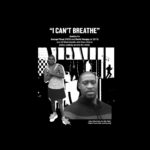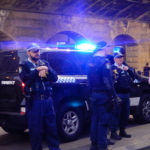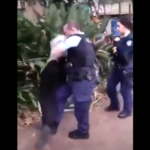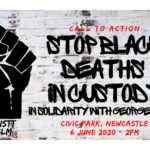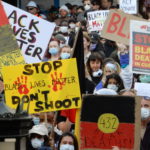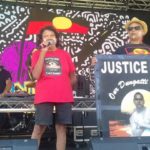Black Lives Matter at Long Bay Prison: Justice Action’s Brett Collins on the Prison Crackdown
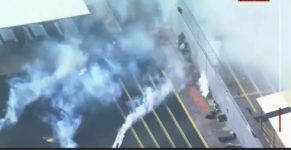
Just days after Black Lives Matter protests swept the nation, reigniting the Aboriginal Deaths in Custody movement in this country, reports started emerging that a similar demonstration was taking place inside Sydney’s Long Bay Gaol.
Indeed, aerial footage shows inmates marking out BLM using towels on the ground in the prison yard. Footage also revealed the extensive use of teargas on the part of Corrective Services NSW, and a mass of heavily armed guards forcing inmates to lay face down on the ground.
However, Corrective Services claimed that the unrest at the notorious correctional facility was actually a result of a couple of fights that broke out over drugs. According to the department, there was nothing political going on, despite the overt solidarity message being displayed.
Black lives matter inside
The 50,000 strong Stop All Black Deaths in Custody- BLM rally that happened in Sydney’s CBD last Saturday had David Dungay Junior as a central focus. The Dunghutti man was only 26 years old when his life was taken by a group of Immediate Action Officers inside Long Bay Gaol hospital ward.
When Dungay, a diabetic, refused to stop eating a biscuit on 29 December 2015, six officers stormed his cell, dragged him into another on, and then five of them forcibly pressed down upon his back, as he lay face down in the prone position, until they killed him.
This Friday afternoon a Stop All Black Deaths in Custody: Solidarity with Long Bay Prisoners rally is being held at Sydney Town Hall. The action is “in response to the inhumane treatment” of Long Bay inmates. And Dungay’s mother, Leetona, will be speaking at the event.
Sydney Criminal Lawyers spoke with long-time prisoner rights advocate Justice Action coordinator Brett Collins about the solidarity BLM actions taken by Long Bay prisoners, the falsehoods propagated in the press about the events, and how things need to change on the inside.
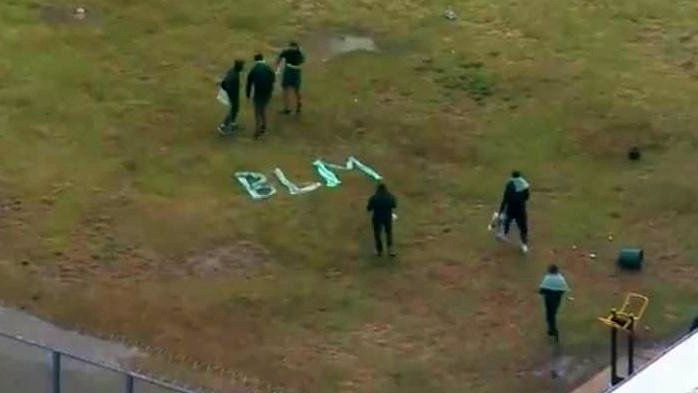
At around midday on Monday, there was a disturbance at Long Bay Gaol. Authorities have said it was related to two fights that broke out in the prison yard.
But, aerial footage shows inmates marking out BLM on the ground, symbolising Black Lives Matter. Brett, in your understanding, what happened at Long Bay?
The Long Bay protest was unsurprising. But, the way that Corrective Services tried to portray it, once again, was outrageous.
The incident itself was a protest by prisoners who are outraged about the lack of changes after the David Dungay inquest and the lack of recommendations from the coroner.
Nothing has changed. Nothing has happened.
They were inspired by the Black Lives Matter protests happening on the streets of Sydney. And they made sure that their voices were heard, as they’re the most affected community of all.
So, in your understanding, this was a BLM protest even though the authorities are denying that?
Absolutely. What the authorities have tried to do is dehumanise prisoners, making out that they have no interest in their own lives. Corrective Services suggest that the only interest they have is using drugs.
It’s also to try and depoliticise them, as if they have no concerns about their futures, their own lives or international events that directly affect them.
That’s outrageous. And what it does is effectively show the level of contempt the authorities have for prisoners, and the advantage they take of their isolation, instead of allowing the media to go in and directly talk to prisoners.
Quite clearly the media could have. The prisoners were submitting. They were lying on the ground accepting the fact that they were to be put back in their cells. There was a chance for the media to talk directly to them.
That’s if they were interested in letting the media hear the truth. But, of course, Corrective Services wants to present its own narrative, which is what they did.
So, what did the incident actually entail?
What happened was a number of persons congregated in the yard and refused to leave. There were some disagreements amongst the prisoners about tactics on how they were going to present it.
And right away, you had immense tensions, because visits aren’t happening inside the gaols. They haven’t happened for almost three months because of the pandemic.
That means you don’t have any of the normal contact with the outside community. People who would normally see their children and their wives haven’t been.
They haven’t had a chance to kiss their wives, hold them and feel as though from week to week, they can actually survive the prison experience. They are now much more hardened by being fully restricted from those contacts.
So, you have all these tensions, playing out inside the prison yards. Young men disagreeing with each other all the time. There’s immense tension there.
Of course, those tensions could be resolved in much seemlier or community building ways, but what we saw was Corrective Services doing the same as they did to David Dungay.
They brought in overwhelming force. They had people who were already submitting lying on the ground and they were still lobbying teargas grenades into the yard.
It was observed by the residents living close to Long Bay that this was something that hadn’t happened before.
In fact, what we had was overwhelming force, and an opportunity to play with new toys – to see how the teargas acted on real people, who were already submitting.
That’s the same as they did to David Dungay, when they brought six members of the Immediate Action Team in and just overwhelmed him.
They hit him in the face with a shield and then squashed the air out of him until he died.
As you’ve mentioned, David Dungay Junior was held face down by prison guards in the hospital ward of Long Bay in December 2015.
This excessive use of force led to his death. How would you describe the way authorities enforced the rules at Long Bay last Monday?
It was the same behaviour. The coroner’s recommendation in the David Dungay inquest was a de-escalation that should be at least 50 percent less of the effort that’s being put into dealing with any disturbance.
That was a very clear statement that came from the coroner and was intended to be taken seriously by Corrective Services. But, in practice, that wasn’t happening on Monday.
There was no question of standing up and discussing things with prisoners or bringing in outsiders to discuss it together.
There was no suggestion of having an expression from the inmates conveyed to the outside community about Black Lives Matter and how they feel that things haven’t changed.
These are all the things that a de-escalation would entail. But, that’s not what happened at all. We all saw it. The media saw it. What you had was people lying face down. And a dog bit someone.
They were all dehumanised in the process. That degradation happens inside a cage – a cage within a cage – and you’re left feeling like it’s a zoo, when in fact, most of those people are out on the streets within a few months.
If they get treated that way, like an animal, then that reflects back on how these people come back out into the community expecting to be treated.
They might then arm themselves expecting to be attacked, which of course, causes greater disturbance and crime within the community.
And lastly, Brett, what would you say this incident tells us? Is it a sign that the way society approaches incarceration needs to change?
Clearly, some major things have to change. The first thing is to start with the youth.
To have 50 percent of kids in youth justice being Indigenous children, says that from the very beginning there’s an immense failure.
Then you factor in the amount of money that’s being spent on this: $530,000 every year for every kid.
That’s an outrageous amount of money, especially when those kids have no prospect of any real education.
And you have over 60 percent of them returning to youth justice centres within two years.
You can start there straightaway. You can refuse to send them to these institutions, regardless of what they do.
You can have mentoring for them in the community and social support. You can start with the kids first of all. Youth detention is the most wrongheaded aspect of it all.
You could also allow people to have access to computers in cells, so they can have fresh ideas coming in from culturally appropriate sources.
You could have Aboriginal leaders, or even just their friends and family, being able to feed into someone who is isolated.
That should happen for adults as well. It has happened in the ACT for the last twelve years.
But, there are no computers inside the cells in youth justice centres. And they’re only just speaking about putting tablets inside cells for the adults.
That’s something they’ve been waiting on for years. It allows people inside their cells to have mainstream education and rehabilitation.
But, none of this is happening, because of the attitude of Corrective Services, which is that they’re dealing with animals and they treat people like animals.
So, you end up with people being degraded in the process.
We saw that in the yard at Long Bay when they dealt with the actions of those showing solidarity with the Black Lives Matter campaigns outside.


